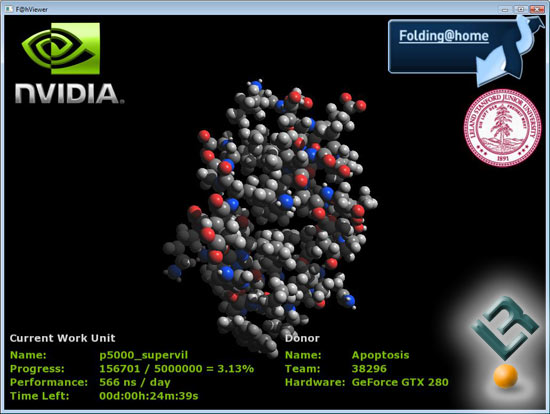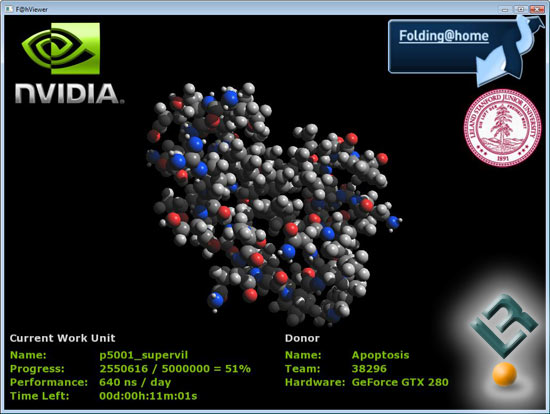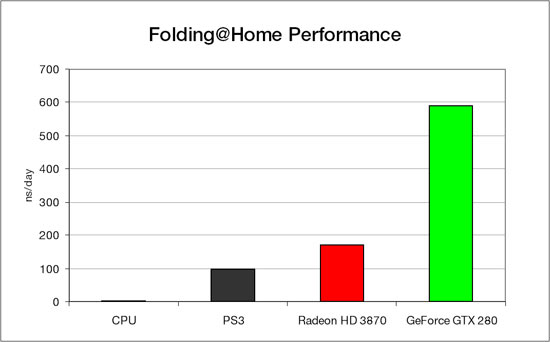NVIDIA GeForce GTX 280 Graphics Cards by EVGA and PNY
Folding on NVIDIA Graphics Cards
Folding@Home, the distributed-computing protein-folding application from Stanford University, runs more than 100 faster on the GPU than on the fastest CPU!

As we previously reported, F@H is coming soon to NVIDIA graphics cards! It seems that the folding team was able to program a folding client in C thanks to the NVIDIA CUDA software environment. NVIDIA has 70 million graphics cards on the market today that can use CUDA programming, which means that the folding project could get a huge boost in performance if more end users would join the project. To see if your video card supports CUDA, check out this list of supporting cards. In the coming weeks the other GeForce cards will be able to run this, but NVIDIA has to release a new driver. Only GeForce GTX 280 and GTX 260 cards with NVIDIA ForceWare 177.34 beta drivers will work at the current time.

The Viewer will display a current Nanoseconds/Day performance rate (number of Nanoseconds simulated on a per-day basis) and is shown above. Why nanoseconds? Protein folding is measured in nanoseconds per day, or how many nanoseconds of the proteins life can be simulated in a days worth of computing time. The Viewer, due in part to its current requirement of moving data off and back to the GPU to render, reduces folding performance. Performance can best be measured after closing the Viewer for a little while and reading the log file. We did that on the PNY GeForce GTX 280 and the EVGA GeForce GTX 280 Hydro Copper 16 to see how overclocking impacts folding performance. Only GeFOrce GTX 260 and 280 cards supporting NVIDIA GPU folding, so we couldn’t use any older GeForce 8 series cards to see how they perform. This pre-release also does not yet take advantage of multiple GPUs in a system. It will work the same whether SLI is enabled or disabled. We still benchmarked the two cards we had and it made for some interesting results as the clocks are different.
- PNY GeForce GTX 280 (602MHz/2214MHz) – 659.542 NS/Day
- EVGA GeForce GTX 280 Hydro Copper 16 (670MHz/2430MHz) – 738.462 NS/Day
The performance went up by nearly 12% thanks to the higher clock frequency of nearly 12%. Seems that the core clock increase directly increases the folding power! On our video card test system the PNY GeForce GTX 280 turned in 5,978 points over 24 hours of doing nothing more than folding. This is a higher point per day output than our 8-core Intel Skulltrail platform running a set of four SMP clients on Linux! While we haven’t had time to run the EVGA GeForce GTX 280 Hydro Copper 16 graphics card for 4 hours doing just folding we would expect it to have roughly a 12% boost in the score since it finished the work units quicker by that percentage. By enabling folding to run on NVIDIA GPU’s many teams will see a huge boost in team performance numbers.

Stanford was able to run same protein and equivalent work units on various platforms and the results shown above are insane. A GeForce GTX 280 can fold at 590 ns/day, compared to 4 ns/day on a CPU or 100 ns/day on the Playstation 3. The ATI Radeon HD 3870 does very well at 180 ns/day, but it’s not enough to compete with the GeForce GTX 280.

Comments are closed.